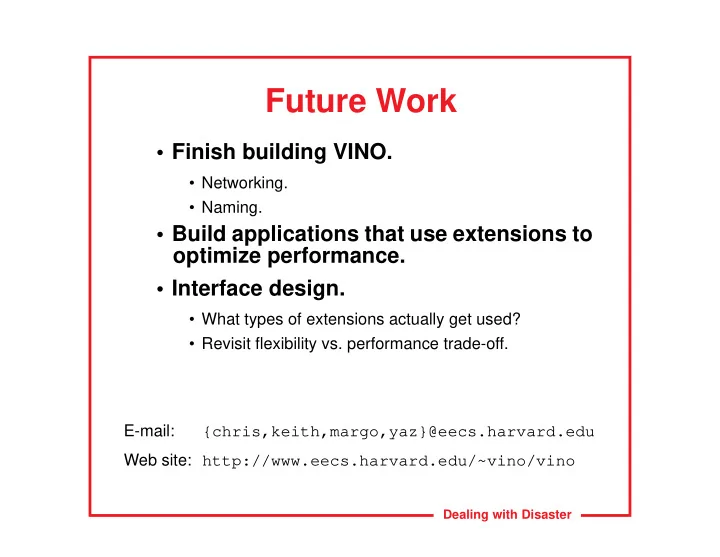

Future Work • Finish building VINO. • Networking. • Naming. • Build applications that use extensions to optimize performance. • Interface design. • What types of extensions actually get used? • Revisit flexibility vs. performance trade-off. {chris,keith,margo,yaz}@eecs.harvard.edu E-mail: Web site: http://www.eecs.harvard.edu/~vino/vino Dealing with Disaster
Conclusions • Possible to build extensible OS. • Extensible OS is a good idea. • Performance trade-off is critical. • Applicable beyond field of operating systems (e.g., to web browsers). Dealing with Disaster
Performance Summary • 100–450 µ s total overhead. • Not cheap. • Negligible when savings is disk I/O. • Untuned implementation. • Not feasible for tiny performance improvement. Dealing with Disaster
Performance Overhead Overhead in µ s RA VM Sched Encrypt Begin 36 52 38 32 Commit 28 34 30 32 Abort 29 27 33 36 Lock 33 34 33 0 Graft 2 160 35 166 Indir 1 1 1 0 SFI 3 26 5 187 Total 103 307 142 417 Dealing with Disaster
Sample Grafts • Measured costs on sample extensions. • VM Page eviction. • Keep important pages in memory. • File read ahead. • Support non-sequential, but known access. • Process scheduling. • Allows group scheduling. • Data encryption. • Adds new functionality. • Filter between user and file system. Dealing with Disaster
Base path VINO kernel code Measuring Performance Null path VINO path Transaction Begin locks Null graft Graft locks Abort path No-SFI path Transaction abort Dealing with Disaster Default policy Transaction End Results checking
Performance • Allowing extensibility has costs. • Extra levels of indirection. • Transaction overhead. • Validation of return value(s). • Cost of graft code. • Software fault isolation. • Abort cost. Dealing with Disaster
Transaction Implementation • Extensions invoked through wrapper. • Begin a transaction. • Switch stacks. • Calls extension. • Commits transaction. • State changes must be logged. • State changes made by accessor methods. • Accessor methods write log records. • Log can be transient. • Implemented as a call stack of undo functions. • If extension fails, abort transaction. • Jump to abort call stack. • Return through each “undo” function. Dealing with Disaster
Transactions • Why? • Guarantee atomicity. • Single mechanism to enforce consistency. • Generally useful tool. • Allows nested extension calls. • How? • Returns kernel to pre-extension state on failure. • Ensures that other threads do not depend on interim extension state. Dealing with Disaster
Handling Failure • Remove extension from kernel. • Undo changes to kernel state made by extension. • Free memory. • Release locks. Dealing with Disaster
Interface Abuse • Misusing legal interface functions. • Fail to release locks. • Fail to free resources (e.g., memory). • Operating system must detect these problems. • Time-out contested locks. • Resource limits. • Trade-off between interface flexibility and potential for abuse. • Disallow locks; require lock-do-unlock interface. • Allow locks; support lock, do, ..., do, unlock interface. Dealing with Disaster
Protecting the Kernel • Extension accesses forbidden memory. • Software fault isolation (VINO). • Safe language (e.g., Java, Modula-3 [SPIN]). • Extension returns invalid data. • Validate return values. • Time-out long running extensions. • Extension calls forbidden functions. • Static check at download time. • Software fault isolation checks indirect jumps. • Check security—extensions have privileges of application that installed them. Dealing with Disaster
Extensibility Challenges • Three interfaces between extension and kernel. • All three interfaces can be abused. Interface: Kernel and extension share memory. Problem: Extension reads/writes private kernel memory. Interface: Kernel calls extension. Problem: Extension returns invalid data (or doesn’t return). Interface: Extension can call other kernel functions. Problem: Extension calls forbidden kernel functions. Dealing with Disaster
VINO Implementation • New kernel design and implementation. • Use NetBSD device drivers and locore. • Object-oriented design (C++). • Design for per-method extensibility. • Highly (overly?) modularized. • Encapsulate every policy decision in a method. • Two extension techniques: Replace or extend methods. Specify event handler. Dealing with Disaster
Extensibility in VINO • Working assumptions • The OS frequently does almost the correct thing. • Often minor tweaks can fix major problems. • Minimize effort to modify kernel behavior. • Design principles • Extensibility should be fine-grain (e.g., function call). • Extensions should look just like kernel code. • Extensions should be able to call kernel functions. Dealing with Disaster
Why Extensibility? • Systems optimize for the common case. • Some important cases are uncommon. • Phenomenon appears in many places. • Database servers. • Download queries. • Download new data types. • Web browsers. • Download applets. • Operating systems. • Download drivers. • Download entire subsystems. • Download minor modifications. Dealing with Disaster
Outline • Why extensibility? • Extensibility in VINO. • Challenges in extensibility. • Performance. Dealing with Disaster
Dealing with Disaster: Surviving Misbehaving Kernel Extensions V E R I T A S Margo Seltzer, Yasuhiro Endo, Chris Small, and Keith Smith Harvard University Division of Engineering and Applied Sciences October 31, 1996
Recommend
More recommend